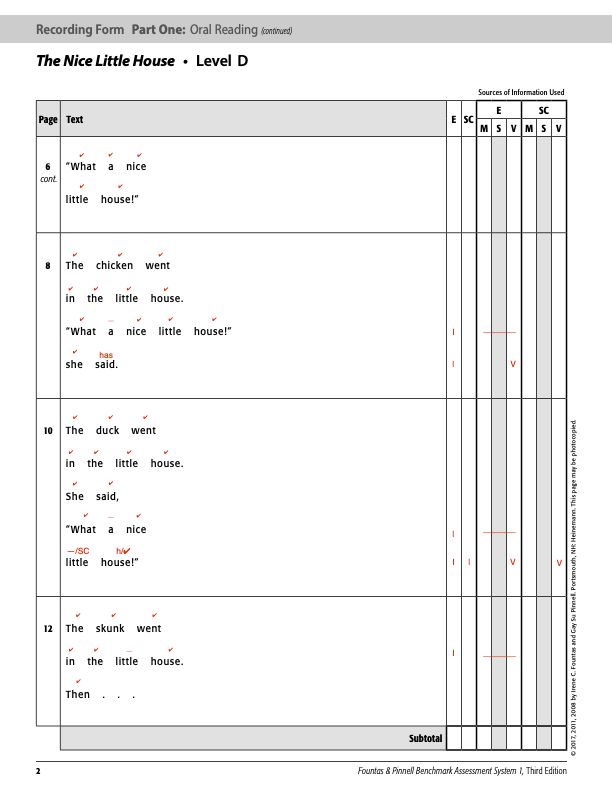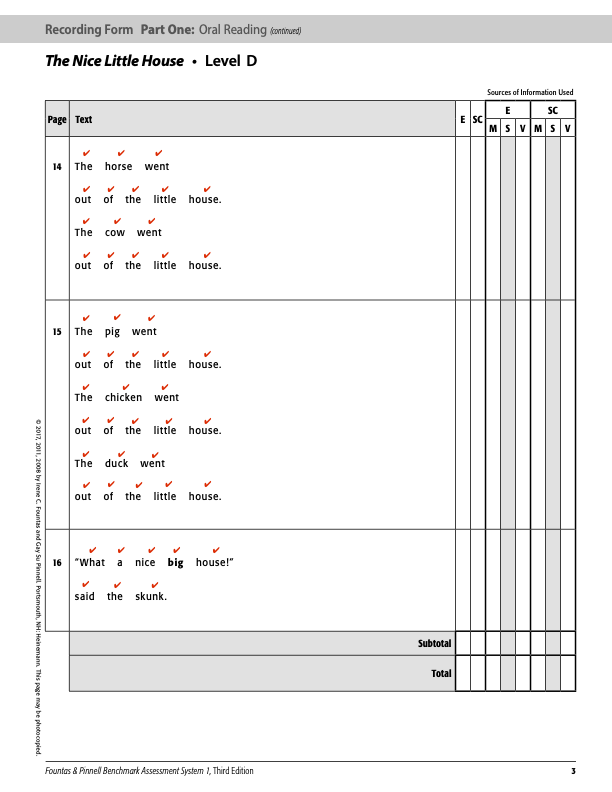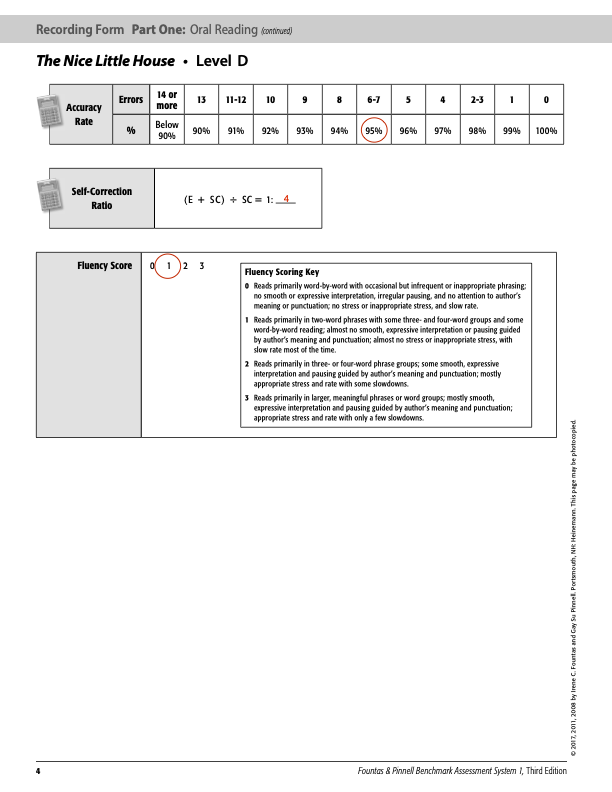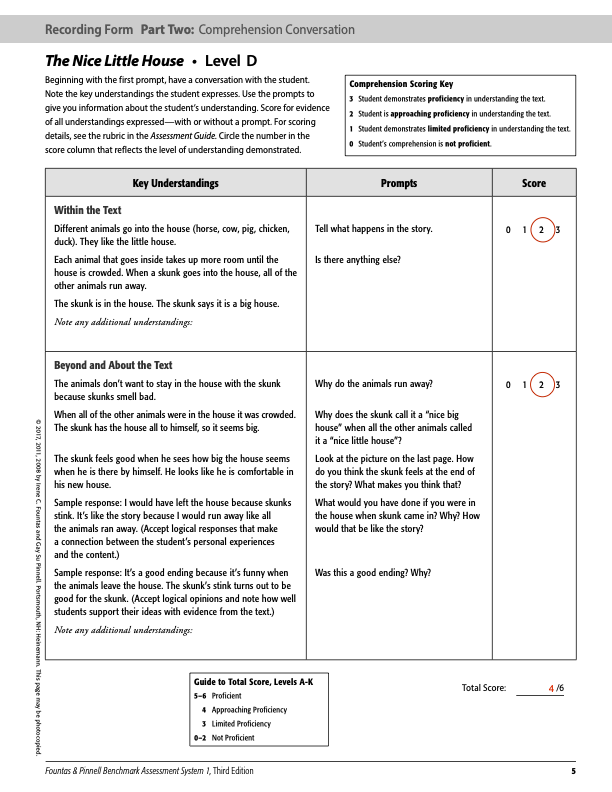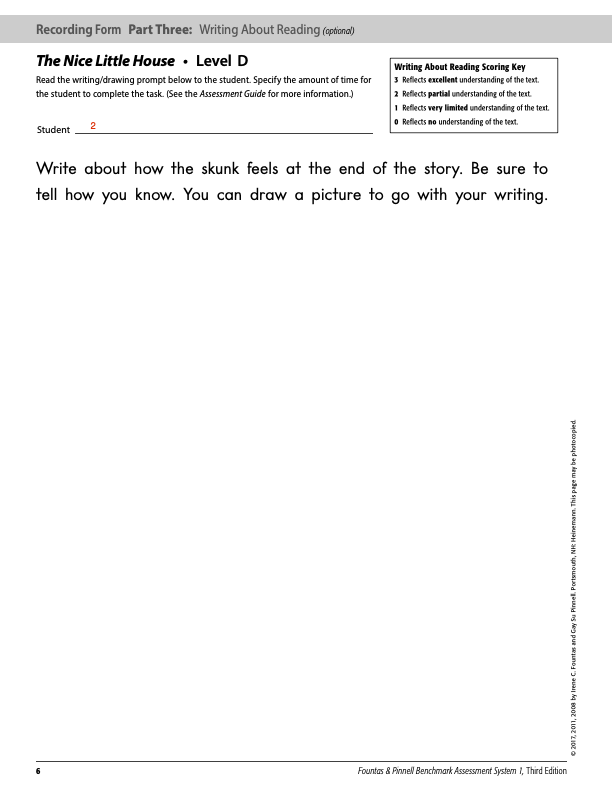Introduction
There are numerous strategies that have proven to be useful when evaluating students’ reading and writing skills. Nevertheless, despite the differences in approaches, they tend to center around marking students’ errors and self-correction. Moreover, a dedicated analysis that implies the application of quantitative data is needed. Therefore, the provided video simulation helps reproduce the in-class atmosphere, which is instrumental for learning how to mark all the mistakes on the spot efficiently. The student was assessed using a story entitled The Nice Little House. The story allows for a comprehensive understanding of the student’s strengths and areas of challenge and can help create a detailed plan aimed at enhancing both reading and writing skills.
Strengths
The student demonstrates key strengths when it comes to reading and comprehension. Nevertheless, she clearly lacks fluency, as most of the phrases consist of just two words. The above-mentioned fact may be attributed to anxiety that a student may feel while being tested. She may be too concentrated on pronouncing each word correctly. Therefore, the student may have deliberately prioritized accuracy over fluency in this case.
Throughout the text, the student makes mistakes, but the frequency diminishes substantially. This feature may be explained by the fact that the story has multiple repetitions. Moreover, the student manages to realize the context and the general idea of the story in a due manner, which rapidly enhances her opportunity to read faster and guess the next word. The student demonstrates the ability to understand all the actions described in the story. Moreover, she puts effort into memorizing the entire chronological order of all the events. Furthermore, the student seeks to provide an explanation for each character’s behavior.
Areas of Challenge
The student’s use of articles is worth noting, as it can be considered one of her crucial areas of challenge. She seems to pay little attention to the importance of articles, as she omits them several times. Nevertheless, it may be attributed to her desire to show increased fluency at times when she feels she knows the next word. Thus, the student also omits little on multiple occasions, meaning that she wants to say a nice house, a common phrase that she usually hears. Therefore, it is of significant importance to explain to her that any text contains unique information.
Moreover, children do not always realize that the information that is being transmitted via texts can be more significant than their perception of it. Therefore, it is crucial to underline the importance of reading any text exactly the way it was written. It is essential to explain how valuable data can sometimes be and how its value may be diminished when people do not hesitate to interpret it freely.
Professionals working with the issue should pinpoint and address it promptly. It is essential to explain all the basic grammatical rules concerning the use of articles. Despite the fact that most native speakers rapidly memorize all the cases where an article is needed, sometimes it may be efficient to pay special attention to the basics that can be explained in a more academic way. This strategy can significantly improve the student’s ability to express her thoughts in a precise manner. Moreover, it will help to reduce the child’s reliance on the way people surrounding her pronounce commonly used phrases.
The above-mentioned issue has proven to be of significant importance. Sometimes, the number of interlocutors a child has access to is substantially limited. Watching TV cannot fully make up for the lack of diversity in this case. Therefore, it is crucial to identify all the issues that have become structural problems in a child’s pronunciation in order to find the most efficient strategies to address them. An academic approach and special attention from professionals are often needed to improve the way a child pronounces certain sounds and phrases. It will substantially enhance the learning process and help the student to sound natural and great. Given that the ability to speak distinctively and correctly substantially enhances people’s self-confidence, the issue should be addressed duly.
The assignment and the simulation provide an excellent opportunity to develop or master the skills that are essential when working with children of that age. It is crucial to evaluate the performance and mark all the mistakes in order to realize the complete picture. Moreover, the detailed plan helps organize the entire process in a way that is essential for determining the issues that may underpin the current problems with reading, writing, and understanding.
Corrections
The student shows the ability to self-correct duly, which signals that attention to detail and analysis can be considered her key strengths. The girl manages to realize that she makes a mistake whenever she mispronounces a word or omits it. Moreover, she learns quickly about her ability to do that efficiently. Thus, she quickly realizes what type of mistake she makes when she omits little for the second time. The analytical skills the student demonstrates at such an age will undoubtedly prove beneficial in her future learning experience. Therefore, professionals working with her should emphasize that skill and help her to enhance it. Reflecting on own mistakes and self-correction are increasingly perceived as outstanding skills in various spheres of life.
Understanding
The student does not seem to comprehend the main idea of the text entirely. She claims multiple times that “skunks spray” and realizes that the smell is unpleasant. Moreover, the student claims that none of the animals liked to be accompanied by an animal that tended to “spray” on multiple occasions. Nevertheless, the student does not seem to realize the funny part of the story and its central idea which is based on different perceptions of the house and the use of the antonym big. When asked about the reason for calling the house big, the student reasonably mentions that the skunk is small. Thus, she demonstrates analytical skills that help her form unbiased perceptions of a situation.
At the same time, the student clearly fails to identify the real issue that makes the skunk claim that the house is big. She does not seem to comprehend the idea that changing circumstances may substantially alter perceptions of the same things. Instead, the student appears to stick to constant variables by empathizing with the fact that a skunk is small and that most premises seem spacious to him.
The student’s identification of the essence of the story’s ending also signals that she has not yet developed the skill necessary to understand certain types of feelings. The student again seems to be concentrating on the fact that “the skunk sprays”. This bright stereotype that initially helps her realize some of the story’s ideas prevents her from further investigating the situation. The student does not seem to realize that a skunk, being an essential character in the story, can experience a broad spectrum of emotions originating from various factors. Thus, the student claims that the skunk simply feels enthusiastic about the opportunity “to spray”.
Alongside other, mostly grammatic-centered, means of enhancing the student’s reading skills proposed in this work, paired reading should be utilized. Given the variety of strengths that the student already demonstrates, it is crucial to further enhance her ability to understand the meaning of different stories. Maureen et al. (2018) emphasize blending a more formal type of instruction with storytelling and assessing the effects on digital literacy skills in early childhood education. A partner may use her ability to grasp some of the meaning and help her to develop a more complex and unbiased perception of the motivation standing behind the characters’ actions. Thus, such practice should be considered a cornerstone of the strategy that seeks to improve the student’s overall performance.
Conclusion
The video simulation has proven to be highly beneficial for acquiring first-hand experience of the assessment process. The student, in this case, demonstrates a variety of strengths, as even her fluency and ability to understand specific actions described in the story are substantial. Nevertheless, the dedicated analysis and the running record assessment are instrumental in determining a range of issues that are to be addressed duly in order to improve reading and understanding skills. Thus, special attention to certain areas of challenge described in the work can substantially enhance the student’s future learning experience.
Reference
Maureen, I. Y., van der Meij, H., & de Jong, T. (2018). Supporting literacy and digital literacy development in early childhood education using storytelling activities. International Journal of Early Childhood, 50(3), 371–389. Web.

